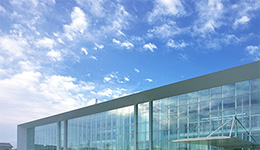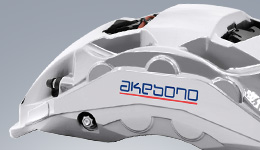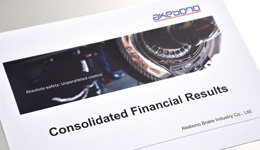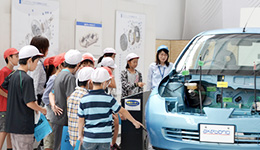Financial Review
- Consolidated Financial Highlights
- Results by Geographical Segment
- Consolidated Assets, Liabilities, Net Asset Conditions
- Consolidated Cash Flow Conditions
- Future outlook
Consolidated Financial Highlights
The Akebono Group's net sales for the fiscal year under review (see Note) decreased to JPY264.9 billion (0.4% year-on-year decrease) reflecting decreases in sales in North America despite strong sales in the European and Asian regions. Profits increased thanks to the effects of measures taken to improve profits in North American operations, increased orders received in the Asian region, etc. Operating profit and ordinary profit were JPY8.1 billion (JPY4.2 billion for the last fiscal year) and JPY5.8 billion (JPY0.8 billion for the last fiscal year), respectively. Profit attributable to owners of parent was JPY0.8 billion (JPY0.4 billion for the last fiscal year) mainly as a result of posting impairment loss for non-current assets in the Arras Plant and the Slovakia Plant in Europe.
- (Note)
- The consolidated fiscal year under review is defined as follows:
- (1) North America, China, Thailand, and Indonesia: January to December 2017
- (2) Japan and Europe: April 2017 to March 2018
→Consolidated Financial Results
Results by Geographical Segment
- (1) Japan
The Akebono Group posted net sales of JPY81.4 billion (0.6% year-on-year increase), favorably affected by increases in orders received for products mainly for new SUVs, as well as also strong sales of industrial machinery and rolling stock products such as those for forklifts and vehicle behavior detection devices for rolling stock, but adversely affected by sluggish exports of compact trucks to the Middle East and decreases in orders received due to production suspension caused by automakers' inspection failings. Operating profit was JPY3.3 billion (19.0% year-on-year decrease) due to the effects of a surge in market prices of steel and other materials, rising labor expenses including performance-linked bonuses as part of the Akebono Group's compensation system, and increases in next-generation R&D expenses related to electro-mechanical brakes, environment-friendly friction materials, etc. - (2) North America
Net sales were JPY139.9 billion (8.7% year-on-year decrease), affected by decreased sales caused mainly by some U.S.-based automakers' withdrawal from sedan models production and tentative inventory adjustment in the aftermarket products market, although sales increased thanks to strong orders received for products for pickup trucks and SUVs and optimization of sales prices. Operating profit soared to JPY1.5 billion (operating loss of JPY3.2 billion for the last fiscal year) mainly because one-time expenses such as external consultant fees were not incurred and expedited freight was significantly reduced through stabilized operations and labor cost reduction through reduced overtime and holiday work were achieved, despite the effects of decreased sales and rising steel and other material prices. - (3) Europe
Net sales were JPY14.1 billion (22.1% year-on-year increase) thanks to increased sales of disc brake calipers for mass produced high performance vehicles despite decreased sales in the aftermarket friction material business. The Akebono Group posted an operating loss of JPY2.0 billion (operating loss of JPY1.3 billion for the last fiscal year) mainly due to various expenses incurred in the Slovakia Plant resulting from its efforts toward the start of full scale production, increased depreciation expenses associated with increased manufacturing lines, rising labor cost associated with the increased number of personnel, and delay in the planned rationalization, as well as a change in product sales mix resulting from declines in the friction material business in the Arras Plant in France, which is highly profitable. - (4) China
The Akebono Group posted net sales of JPY22.5 billion (12.5% year-on-year increase) thanks to strong sales of products for SUVs and newly received orders for new models. Operating profit was JPY2.6 billion (2.8% year-on-year increase) mainly thanks to favorable orders received for highly profitable friction material products and successful rationalization of production, despite increases in labor cost, depreciation, and costs of complying with environmental regulations, thus showing year-on-year increase in sales and profits. - (5) Thailand
Net sales were JPY7.9 billion (19.0% year-on-year increase) thanks to increased orders received for products for both domestically sold and exported compact cars and to favorable orders received for aftermarket friction material products. Operating profit was JPY0.5 billion (14.4% year-on-year increase) thanks to increased sales despite the effects of increases in labor cost and cost of starting up a foundry that began operations last year, thus showing year-on-year increases in sales and profits. - (6) Indonesia
Net sales rose to JPY18.8 billion (14.9% year-on-year increase) mainly due to favorable sales for products for new MPVs (multi-purpose vehicles) and increases in orders received for products for global platform vehicles (common platforms for global distribution) exported to Europe and for motorcycles. Operating profit soared to JPY2.0 billion (41.4% year-on-year increase) because one-time expenses associated with the new business startup that began operations last year were not incurred and profit was driven by the rationalization of production and increased orders, thus showing year-on-year increases in sales and profits. - * Posting impairment loss
The Arras Plant (France) and the Slovakia Plant, both in Europe, failed to meet the planned performance in the past. As such, the Akebono Group has reviewed the future collectability conservatively and determined that there is an indication of impairment. As a result, the Akebono Group decided to post impairment loss of JPY0.8 billion (EUR 6 million) for the Arras Plant and JPY0.7 billion (EUR 5 million) for the Slovakia Plant. With a variety of measures for improvement including acquisition of new business, enhancement of rationalization (productivity and procurement) being planned and implemented for the two plants, the Akebono Group aims to put the Arras Plant and the Slovakia Plant into the black in fiscal 2020 and fiscal 2019, respectively. - * Effects of foreign exchange fluctuations on earnings
The Akebono Group implements measures aimed at avoiding foreign exchange risk, but the following effects were identified in the fiscal year under review.- Net sales: JPY5.5 billion year-on-year increase due to the effect of foreign exchange.
- Operating profit: JPY0.04 billion year-on-year decrease due to the effect of foreign exchange.
- Non-operating income: Exchange differences at the time of posting of sales, purchase and settlement resulted in foreign exchange gains of JPY0.15 billion.
→Results by Geographical Segment
Consolidated Assets, Liabilities, Net Asset Conditions
(Assets)
Current assets decreased by JPY7.3 billion from the end of the last fiscal year to JPY68.5 billion due primarily to a JPY2.9 billion decrease in cash and deposits as a result of loan repayment, etc. and a decrease in accounts receivable in North America.
Non-current assets decreased by JPY0.2billion from the end of the last fiscal year to JPY125.9 billion due mainly to a JPY1.5 billion decrease in property, plant and equipment arising from posting impairment loss of JPY1.5 billion, despite a JPY1.2 billion increase in investment securities resulting from higher share prices.
(Liabilities)
Current liabilities fell by JPY6.8 billion from the end of the last fiscal year to JPY87.4 billion due mainly to a JPY5.1 billion decrease in the interest-bearing debt primarily in North America.
Non-current liabilities also fell by JPY2.8 billion from the end of the last fiscal year to JPY75.5 billion due mainly to a JPY3.3 billion decrease in interest-bearing debt.
Moreover, the net interest-bearing debt balance calculated by deducting cash and deposits from the interest-bearing debt balance (JPY109.7 billion) fell by JPY5.5 billion from the end of the last fiscal year to JPY97.0 billion.
(Net assets)
Net assets at the end of the fiscal year under review rose by JPY2.1 billion from the end of the last fiscal year to JPY31.5 billion due mainly to increased retained earnings as a result of posting JPY0.8 billion profit attributable to owners of parent, a JPY0.8 billion increase in valuation difference on available-for-sale securities resulting from higher share prices and a JPY0.2 billion increase in foreign currency translation adjustment arising from the influence of foreign exchange.
→Consolidated Financial Performance
Consolidated Cash Flow Conditions
Cash and cash equivalents at the end of the fiscal year under review decreased by JPY2.9 billion from the end of the last fiscal year to JPY12.7 billion.
(Cash flows from operating activities)
The main factors behind the net cash inflow include profit before income taxes of JPY4.2 billion, depreciation of JPY12.4 billion, a JPY2.9 billion decrease in working capital, etc. while income taxes of JPY2.8 billion were paid out.
(Cash flows from investing activities)
The main factor behind the net cash outflow is the payment of JPY11.4 billion for purchase of property, plant and equipment in connection with capital investment mainly in Japan, U.S., and Europe.
(Cash flows from financing activities)
The main factors behind the net cash outflow include a JPY3.4 billion net decrease in short-term loans payable, repayment of JPY25.3 billion long-term loans payable, and JPY3.1 billion dividends paid to non-controlling interests, while there were inflows of JPY19.2 billion through proceeds from long-term loans payable and JPY2.1 billion through proceeds from sale and leaseback.
Future outlook
In May 2016 (fiscal 2016), the Akebono Group established a new midterm business plan, "akebono New Frontier 30 – 2016 (hereinafter "aNF30-2016")" ending in fiscal year 2018. The fiscal year under review is the second fiscal year of aNF30-2016. In the fiscal year under review, the Akebono Group achieved its targets for net sales and operating profit. For free cash flow in particular, the Akebono Group successfully generated cash totaling JPY8.3 billion, which substantially exceeded the target of JPY3.0 billion.
It is said that the automotive industry has entered an era of once-in-a-century transformation. In order to quickly respond to such drastic and rapidly changing business environment and to realize to sustainable growth with the aim of returning to a sound financial condition, the Akebono Group introduced a new business structure of product-based business units (BU) successively from fiscal 2016 onward. We believe that the new business structure will get the most out of the Akebono Group's unique position of a "Small, Specialized, Independent Manufacturing Company." While there are still issues such as efficient collaboration between BU and head office functions, and between BU and overseas businesses, we intend to strengthen our competitiveness in the existing business operations and expand new business areas, through a full scale introduction of the BU. The aNF30-2016 aims at a "Return to a sound financial condition" by implementing various measures under its three pillars below.
- 1) Rebuilding North American operations
- 2) Establishing global networks based on product-based business units
- 3) Expanding the high performance brake (mass produced high performance brakes) business and recreating European operations
Progress of aNF30-2016 and future outlook are described below.
- (1) Rebuilding North American operations
Due to the production issues occurring since fiscal year 2014 that arose from a surge in received orders, performance of North American operations worsened, resulting in significant losses posted for these consecutive years. For that reason, the Akebono Group has positioned “Rebuilding North American operations” as its biggest management issue and worked to stabilize earnings as early as possible. As a result of various measures taken for the four initiatives—1) Fundamental organizational reforms, 2) Productivity improvement, 3) Increase of manufacturing capacity and 4) Improvement of earnings structure—the Akebono Group successfully posted operating profit of JPY1.8 billion in the United States alone in fiscal year 2017. Although Rebuilding North American operations has been successful, net sales are expected to decline in the coming years due to withdrawal from sedan models production by some customers and failure to receive orders for a next model as a result of the production issues. However, we will continue our efforts to optimize production operations. Given some new generation issues arising from major reforms measures led by the local management, we consider that the Akebono Group has entered another reform phase that cannot be dealt with by its US management alone. In order to realize future growth, we will strive to further improve North American operations by returning to the origin of a manufacturing company based on Japan's “Monozukuri” (manufacturing excellence) and further deepening collaboration between Japan and the United States. - (2) Establishing global networks based on product-based business units
Aiming to improve profitability per product and strengthen its global competitiveness, the Akebono Group has started to shift to five product-based business units (BU) structure from fiscal 2016 onward. Specifically, by dividing its products into the following five categories, the Akebono Group has made each BU responsible for the marketing, R&D, manufacturing and sales functions for the respective products, and manage the respective businesses including the bottom line, in a consistent manner.
Meanwhile, head office functions include development of next-generation products, which is one of the most important challenges for the Akebono Group, development of materials and technologies in new fields, cultivation of new businesses in rapidly changing mobility field, creation of business models. While necessary functions shift to the BU structure is still in progress, we will complete the transition by the end of fiscal year 2018 as initially planned.Business Units (BU) Main Products HP BU HP (High performance) disc brakes Foundation BU Disc brakes, drum brakes and other mechanical parts Infrastructure and Mobility (AIMS) BU Products for industrial machinery, rolling stock, and sensors Friction Material BU Brake pads, lining and other friction materials Aftermarket BU Aftermarket products
A major challenge at present is efficient collaboration between BU and head office functions and between BU and overseas operations, etc. We will continue to work on this challenge in this fiscal year.
Under the next midterm business plan, the Akebono Group will start a full scale launch of the next-generation products that will replace the current disc brakes, which were mainstream for half a century. In the field of infrastructure and mobility, we are planning not only to develop products using automotive related technologies but also to expand into information provision services centered on sensor products in the future, and will build the foundation for this. - (3) Expanding the high performance brake (mass produced high performance brakes) business and recreating European operations
The Akebono Group has worked on development of mass produced high performance disc brake products for the past few years. High performance vehicles boast high output ane the load on the brakes is very high. We have been working on a major challenge of developing brakes that can withstand this load, gaining recognition for such products from customers. In fiscal year 2017, we sequentially transferred to the Slovakia Plant the production of mass produced high performance brake products which were manufactured at the Columbia Plant in the United States and exported to Europe, toward a full scale operation of the Slovakia Plant. While there were various issues that could arise at an initial stage, including generated more scraps than expected in the Slovakia Plant, the need to dispatch a large number of Japanese experts to train local operators, and responses to new customers in the field of mass produced high performance vehicles, these issues have been properly dealt with and preparations for a full scale operation have been almost completed. Although expected to post losses in fiscal year 2018 as well, the Akebono Group will reorganize structures that is able to switch back to profit next fiscal year 2019.
As for future development of the high performance brake business, we are committed to technologies to achieve the highest performance, planning to start global expansion including North America and Japan in addition to Europe.
As for European operations, we are formulating a new business plan based on selection and concentration, in which products for mass-produced high-performance vehicles are added to the friction material products business manufactured in France. Implementation of various measures is planned with the aim of turning it into profitability in fiscal year 2020.
We have been striving to increase profits by working on these three major initiatives and other initiatives. Through these efforts, Asian region has achieved operational results exceeding the plan. As for the goal of aNF30-2016, “Return to a sound financial condition,” we believe that the Akebono Group has achieved certain results although it is halfway through the targets. Free cash flow increased by JPY10.0 billion year on year to JPY8.3 billion. Interest-bearing debt decreased by JPY8.4 billion and net interest-bearing debt decreased to JPY97.0 billion. Equity ratio rose from 12.4% last fiscal year to 13.9%. These indicate that certain results have been produced. It will take some more time to achieve the long-term goals of “Equity ratio of 20-30%” and “Substantial reduction of interest-bearing debt,” but we are aiming at further improvement in fiscal 2018, the final year of aNF30-2016.
For the next fiscal year, the Akebono Group expects net sales of JPY244.4 billion, operating profit of JPY7.5 billion, ordinary profit of JPY5.4 billion, and profit attributable to owners of parent of JPY2.0 billion.
| FY2017 actual results |
FY2018 forecast |
YoY Change | |
|---|---|---|---|
| Net sales | 264.9 | 244.4 | (20.5) |
| Operating profit | 8.1 | 7.5 | (0.6) |
| Ordinary profit | 5.8 | 5.4 | (0.4) |
| Profit before income taxes | 4.2 | 5.1 | 0.9 |
| Profit attributable to owners of parent | 0.8 | 2.0 | 1.2 |
<FY2018 earnings forecasts by geographic region>
| Net sales | Operating profit (loss) | |||||
|---|---|---|---|---|---|---|
| FY2017 actual results |
FY2018 forecast |
YoY Change |
FY2017 Actual results |
FY2018 forecast |
YoY Change |
|
| Japan | 81.4 | 79.9 | (1.5) | 3.3 | 3.0 | (0.3) |
| North America | 139.9 | 114.5 | (25.4) | 1.5 | 0.0 | (1.5) |
| Europe | 14.1 | 19.1 | 5.0 | (2.0) | (0.9) | 1.1 |
| Asia | 49.2 | 49.4 | 0.2 | 5.1 | 5.2 | 0.1 |
| Eliminations | (19.6) | (18.5) | 1.1 | 0.2 | 0.2 | (0.0) |
| Total | 264.9 | 244.4 | (20.5) | 8.1 | 7.5 | (0.6) |
Japan:
For Japanese operations in fiscal year 2018 the Akebono Group expects net sales to be JPY79.9 billion (1.8% year-on-year decrease) and operating profit to be JPY3.0 billion (10.2% year-on-year decrease) as a result of efforts toward rationalization of production etc. despite the effects of declining sales and rising labor cost, etc.
North America:
For North American operations in fiscal year 2018 the Akebono Group expects net sales to be JPY114.5 billion (18.2% year-on-year decrease) and operating profit to be JPY0.0 billion (operating profit of JPY1.5 billion for the last fiscal year) due to the effects of declining sales despite the effects of improving labor cost and cost reduction.
Europe:
An increase in sales is expected mainly due to higher sales of disc brake products for mass produced high performance vehicles and operating loss is expected to fall by JPY1.1 billion year on year to JPY0.9 billion due to the effects of an increase in sales and a reduction in scrap cost resulting from improving yield rate etc.
Asia:
Operating profit is expected to remain at the same level as the last fiscal year due to the effects of higher sales and rationalization despite negative factors such as rising labor expense and increasing depreciation expenses associated with capital investment. In Thailand, losses are expected due to initial costs associated with the launch of a foundry in addition to price increases and rising personnel expenses. However, the Akebono Group expects that net sales will further increase from the fiscal year under review and is committed to bringing this into profit.






